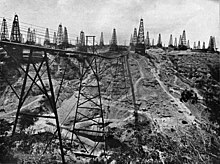Oil and gas industry in Myanmar

Burma, officially known as Myanmar, is a developing country and an important natural gas and petroleum producer in Asia. It is home to one of the world's oldest petroleum industries, with its first crude oil exports dating back to 1853.[1] Today, the country is one of the major natural gas producers in the Asian continent.[2] Decades of isolation, sanctions, a lack of technical capacity, opaque government policies and insufficient investment has impeded the country's efforts to develop an upstream hydrocarbon sector.[3] Recent but slow political reform has led the international community to ease sanctions on Burma, giving rise to hopes of greater investment and economic growth.
History
Early British explorers in Burma discovered a flourishing oil extraction industry in the town of Yenangyaung in 1795.[4] The area had hundreds of hand-dug oil wells under the hereditary control of 24 Burmese families.
British Burma exported its first barrel of crude oil in 1853.[5] The London-based Burmah Oil Company (BOC) was established in 1871 and began production in the Yenangyaung field in 1887 and the Chauk field in 1902. BOC enjoyed a monopoly in the sector until 1901, when the American Standard Oil Company launched operations in Burma.[2] Oil supplies largely met the demand of British India. Prior to World War II and the Japanese invasion of Burma, oil production stood at 6.5 million barrels annually.[6] After independence in 1948, Burma continued to be one of the more prosperous nations in Asia due to its petroleum industry and agricultural exports.
In 1963, the socialist military government led by Ne Win nationalized the sector, causing decades of economic stagnation.[1]
After 1989, the military junta began opening up the country to more foreign investment. Shell discovered the Apyauk gas field 50 kilometres northwest of Yangon in 1991.[7]
Current status
Burma is today primarily a natural gas producer. As of 2015, Burma exports gas to Thailand and China.[3] Burma had proven gas reserves of 10 trillion cubic feet in 2012, with an annual production capacity of 416 BcF.[8] Oil reserves in 2013 numbered at 50 million barrels, with a production capacity of 21,000 bbl/d.[8] The Yenangyaung oil field continues to be in operation.
The country has classified 51 onshore blocks and 53 offshore blocks, including 26 deep water blocks, for oil and gas exploration.[6]
The National Energy Management Committee regulates the sector under the Ministry of Energy. The industry consists of three key state players:[2]
- Myanma Oil and Gas Enterprise, created in 1963; responsible for exploration, production and domestic gas transmission through a 1,200-mile onshore pipeline network.
- Myanma Petrochemicals Enterprise, operates small refineries and fertilizer plants
- Myanmar Petroleum Products Enterprise, responsible for retail and wholesale distribution of petroleum products
Major international oil companies (IOCs) engaged in Burma include Total S.A., the Essar Group, CNOOC, Petronas and Sinopec.[9]
Local companies such as Parami Energy Group and MPRL are some who are leading players in this field. According to Kwong Weng Yap, Chief Operating Officer of Parami, he said in a speech to the ASEAN community that the Burmese oil and gas industry requires a clean government and local inclusion for it to be sustainable in the near term.[10]
The downstream distribution network in Burma remains very under-developed.
See also
References
- ^ a b "Total Myanmar - Oil and Gas in Myanmar". Burma.total.com. Retrieved 2015-04-17.
- ^ a b c https://www.gov.uk/government/uploads/system/uploads/attachment_data/file/393763/UKTI_Burma_-_Oil_and_Gas_Report_-_Jan_2015.pdf
- ^ a b "U.S. Energy Information Administration (EIA)". Eia.gov. Retrieved 2015-04-17.
- ^ Longmuir, Marilyn V. "Oil in Burma: The Extraction of "Earth Oil" to 1914". Bangkok: White Lotus (2001) ISBN 974-7534-60-6 pp.329
- ^ khiggins (2014-02-01). "Journal of Petroleum Technology - Focus on Myanmar". Spe.org. Retrieved 2015-04-17.
- ^ a b http://www.myanmar-oilgas.com/OilGas/media/Site_Images/Day-2-AM-1-EPD-Petroleum-Sector-Prospects.pdf
- ^ http://www-wds.worldbank.org/servlet/WDSContentServer/IW3P/IB/1995/06/20/000009265_3961019114742/Rendered/PDF/multi_page.pdf
- ^ a b http://www.eia.gov/countries/country-data.cfm?fips=bm
- ^ "Factbox - Myanmar's oil and gas sector, one of world's oldest | Reuters". Uk.reuters.com. 2012-01-06. Retrieved 2015-04-17.
- ^ "Factbox - Myanmar's oil and gas industry; ASEAN Energy Business Forum". 2015-06-11. Retrieved 2015-11-06.
